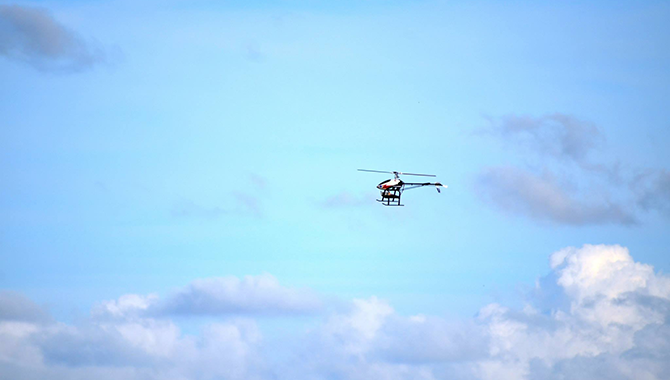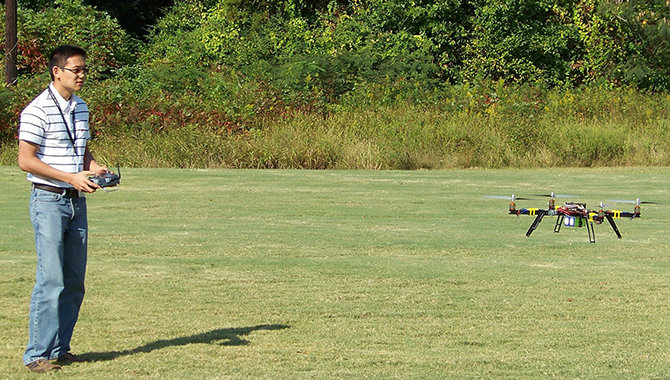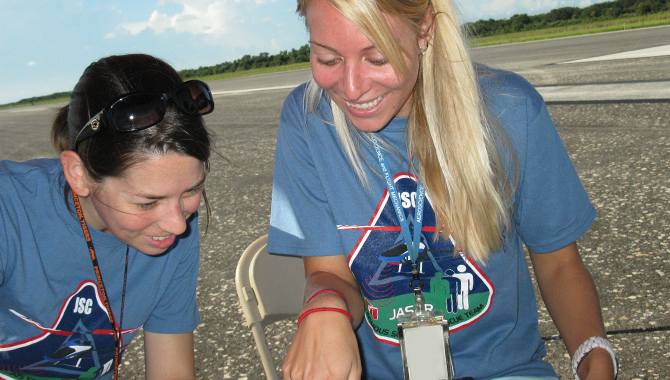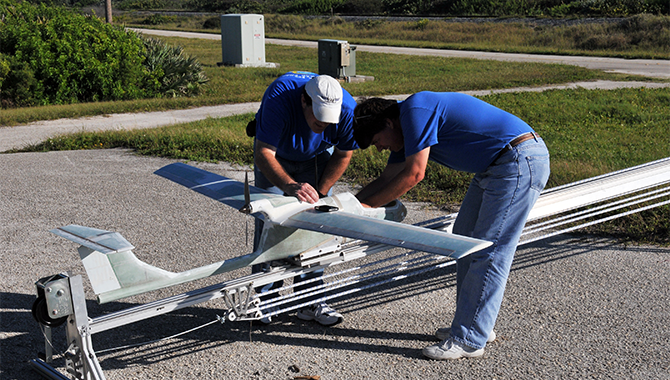
A mock search and rescue mission provided three young engineering teams the opportunity to learn about NASA’s systems engineering and project management principles.
On Thursday, September 11, 2013, at the north end of Kennedy Space Center’s (KSC) space shuttle landing runway, three teams of young engineers gathered to compete in NASA’s first Unmanned Aerial Systems (UAS) Competition. A hexacopter from Marshall Space Flight Center, a fixed-wing aircraft from Kennedy, and a T-Rex 700 R/C helicopter from Johnson Space Center (JSC) launched in series to compete in a two-part mock search and rescue challenge.
The competition, hosted by Kennedy and the Academy of Program/Project & Engineering Leadership (APPEL), was part of the center’s Rocket University (“Rocket U”) program. Founded in 2011, Rocket U is a training and development effort designed to grow and maintain flight systems engineering skills and expertise at NASA.
“The goal of Rocket University is to learn and develop more relevant technological skill sets that our workforce may not have been exposed to while working on well-established spaceflight programs like Shuttle,” explained Mike DuPuis, head of the Rocket U UAS Lab. “Rocket U is a mechanism for exposure to current technologies and to start building those more contemporary engineering skill sets in our workforce.”
September’s competition served as Rocket U’s inaugural effort to expand the program’s reach and encourage interaction and collaboration among engineers across NASA’s centers. Originally the brainchild of KSC Chief Engineer for NASA’s Commercial Crew Program Steve Sullivan and Technical Assistant to the JSC Director of Engineering Gail Chapline, the two hatched a plan to further NASA’s engineering talent and expertise through a series of inter-center competitive and cooperative activities.
“If you read through things like the Columbia Accident Investigation Board Report and the Diaz response, there’s a continuous—and this has gone all the way back to Challenger—concern about the way NASA outsources technical expertise and an eroding technical base within the engineering community,” explained Dr. Chris Iannello, a NASA Engineering and Safety Center (NESC) technical fellow for electrical power and co-founder of KSC’s Rocket U program. “This competition, as well as Rocket U overall, provides a way for NASA engineers to get current on the latest and greatest.”
When the space shuttle first flew in the 1970s, Iannello explained, it was comprised of cutting-edge avionics for the time. “At the end of that program we had very hardworking, capable engineers (some whom were very young) that were experts in systems that were kind of on the dated side,” said Iannello. “These kinds of competitions allow us to ‘sharpen the saw’ technically, and to try to work on those concerns about eroding technical capabilities.”
Utilizing a partnership with APPEL and focusing on low-cost, low-risk platforms, Kennedy’s Rocket U program issued a competition call, providing each team with $12,500 and approximately one year to build their UAS. The teams could choose any type of vehicle, but it had to be partially autonomous and safely apply and execute NASA’s systems engineering and project management principles. Additionally, time spent on the competition could not interfere with their day-to-day work.
Provided a fixed area (600 ft x 1,000 ft), each team’s vehicle went in search of strategically placed mannequins. Flying no higher than 1,000 ft, the first round of the competition challenged each team to deploy their vehicle over an open field and look for the mannequins dressed in bright orange clothing. Each team’s UAS had to identify the location of the targets, relay the coordinates back to an operations ground base, and then safely return to home base.
Round 2 took the competition one step further. In rough, tree-lined terrain, each team was asked to locate the mannequins now dressed in street clothes and camouflage.
Throughout the competition, a panel of judges assessed and scored each team based on their project plan, Flight Readiness Review plan and presentation, flight demonstration, and post-flight debrief. In the end, Marshall took first place, followed by Johnson and then Kennedy.
However, while competitions of this sort typically motivate teams to achieve an admirable ranking among other contenders, which team came in first or last for the Rocket U UAS Competition was far from what actually mattered. Upon reflection, each of the competition teams consistently identified the hands-on experience with NASA’s processes, people, and hardware as the true reward.
Over the next several weeks, APPEL will release excerpts from a series of interviews done with the members and mentors from each of the competition teams. Each interview captures specific insights and reflections on the learning and experience gained by the competition participants.
To catch the latest releases, get connected to APPEL through social media, the APPEL RSS feed, and by subscribing to the APPEL News Digest.
Learn more about Rocket University at NASA.
Read the team interviews:
Click to view full photo gallery on Flickr.
The JSC helicopter in flight on the day of the competition.
Featured Photo Credit: NASA Marshall Space Flight Center / Adam Kimberlin
Editor’s note: (2/3/2014) The first sentence of this article was modified to better clarify the intent of the competition.









